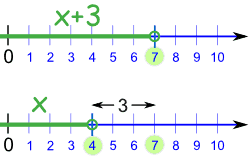Solving Inequalities
Sometimes we need to solve Inequalities like these:
Symbol
|
Words
|
Example
|
|---|---|---|
| > |
greater than
|
x + 3 > 2
|
| < |
less than
|
7x < 28
|
| ≥ |
greater than or equal to
|
5 ≥ x − 1
|
| ≤ |
less than or equal to
|
2y + 1 ≤ 7
|
Solving
Our aim is to have x (or whatever the variable is) on its own on the left of the inequality sign:
| Something like: | x < 5 | |
| or: | y ≥ 11 |
We call that "solved".
How to Solve
Solving inequalities is very like solving equations ... we do most of the same things ...
... but we must also pay attention to the direction of the inequality.

Direction: Which way the arrow "points"
Some things can change the direction!
< becomes >
> becomes <
≤ becomes ≥
≥ becomes ≤
Safe Things To Do
These things do not affect the direction of the inequality:
- Add (or subtract) a number from both sides
- Multiply (or divide) both sides by a positive number
- Simplify a side
But these things do change the direction of the inequality ("<" becomes ">" for example):
- Multiply (or divide) both sides by a negative number
- Swapping left and right hand sides
Here are the details:
Adding or Subtracting a Value
We can often solve inequalities by adding (or subtracting) a number from both sides (just as in Introduction to Algebra), like this:
What did we do?
We went from this:
To this:
|  |
x+3 < 7
x < 4
| ||
And that works well for adding and subtracting, because if we add (or subtract) the same amount from both sides, it does not affect the inequality
What If I Solve It, But "x" Is On The Right?
No matter, just swap sides, but reverse the sign so it still "points at" the correct value!
Note: "x" can be on the right, but people usually like to see it on the left hand side.
Multiplying or Dividing by a Value
Another thing we do is multiply or divide both sides by a value (just as in Algebra - Multiplying).
But we need to be a bit more careful (as you will see).
Positive Values
Everything is fine if we want to multiply or divide by a positive number:
Negative Values
| When we multiply or divide by a negative number we must reverse the inequality. |
Why?
Well, just look at the number line!
For example, from 3 to 7 is an increase,
but from −3 to −7 is a decrease.
but from −3 to −7 is a decrease.
 | |
| −7 < −3 | 7 > 3 |
See how the inequality sign reverses (from < to >) ?
Let us try an example:
(Note that I reversed the inequality on the same line I divided by the negative number.)
So, just remember:
When multiplying or dividing by a negative number, reverse the inequality
Multiplying or Dividing by Variables
Here is another (tricky!) example:
To help you understand, imagine replacing b with 1 or −1 in the example of bx < 3b:
- if b is 1, then the answer is x < 3
- but if b is −1, then we are solving −x < −3, and the answer is x > 3
The answer could be x < 3 or x > 3 and we can't choose because we don't know b.
So:
Do not try dividing by a variable to solve an inequality (unless you know the variable is always positive, or always negative).
A Bigger Example
Two Inequalities At Once!
How do we solve something with two inequalities at once?
Summary
- Many simple inequalities can be solved by adding, subtracting, multiplying or dividing both sides until you are left with the variable on its own.
- But these things will change direction of the inequality:
- Multiplying or dividing both sides by a negative number
- Swapping left and right hand sides
- Don't multiply or divide by a variable (unless you know it is always positive or always negative)
No comments:
Post a Comment